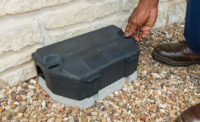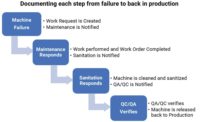In snack and bakery production, the internet of things (IoT) is essential—it can streamline production via connected sensors or RFID, and then feed data back for analysis. From this analysis, companies can figure out how and why things slow down—and how to prevent slowdowns in the future. They can also figure out how to save energy, improve throughput and keep production safer.
Maximizing capabilities
“The internet of things is already having an impact on our day-to-day lives,” says Jay Wright, vice president, sales, SOMAX, Inc., Alpharetta, GA. “Our phones measure how many steps we walk per day, our homes now have smart thermostats and doorbells—everything is becoming more connected.”
The same is true of the plant floor, adds Wright. “Machinery is becoming smarter and more connected.” IoT sensors to monitor temperature, moisture, humidity and vibration are now inexpensive and widely available. “A temperature sensor can be installed anywhere for continuous monitoring of ambient temperature, or even something specific like motor temperature,” he says.
This can have a profound impact on plant operations, says Wright. “Why would you continue to have someone inspect something once a week when a low-cost sensor can be installed and inspect it once a minute? IoT and digital transformation can make our lives easier and give us the information needed instantly.”
Real-time operating systems linked to enterprise database solutions are increasingly popular because they provide food companies with a real-time, clear picture of total operational performance, and accurate recordkeeping of all machine inputs, outputs and issues that impact food security, says Sean Riley, senior director, media and industry communications, PMMI, Reston, VA. IoT platforms and middleware can connect physical devices and data endpoints with higher-level software applications like artificial intelligence, predictive analysis and cognitive computing, he notes. “IoT has the potential to radically change operations.”
However, snack and bakery companies should always identify goals before implementing any new IoT technology, says Daymon Thompson, automation program manager, North America, Beckhoff Automation, Savage, MN. “The food manufacturer must decide whether they want, for example, to reduce material waste, implement better track and trace, or improve other important aspects of production. These goals will determine what technologies to implement and create a strategic plan to incorporate the cloud into production to generate significant results.”
Improving via IoT
PMMI offers six considerations for determining how to improve implementation of IoT, says Riley:
- Specify—what is the problem?
- Success—what does success mean for this project?
- Start small—verify success on limited number of lines, then look to scale up.
- Senior support—engage senior leadership with a long-term vision for the technologies.
- Shared responsibility—are the IT and OT teams involved?
- Support staff—get your people involved to support the new applications.
Stellar, Jacksonville, FL, uses barcoding to help with product tracking. “Not only is this useful for tracing ingredients, lot numbers and manufacturing dates for finished products, but barcodes can also help validate ingredients in the production process,” says Gerry Gomolka, product developer, process improvements.
Kevin Wilson, senior project engineer, says that Stellar has utilized internet-connected sensors in certain projects to make restocking of bulk materials more efficient in a facility. “The sensors are installed in the vessels where bulk ingredients—such as oils, flour or liquid sugar—are stored. When the sensor detects that the contents are below a certain level, it automatically places an order to replenish that ingredient.” This technology can also be used for restocking sanitizing chemicals, he says.
“Companies are already benefiting from the IoT through cost savings due to predictive maintenance, improved safety and other operational efficiencies,” says Wright. “Early detection of potential problems is critical for any organization. Continuously monitoring asset condition and performance is the best way to get ahead of asset failures.”
Wright says that a low-cost temperature sensor (usually under $100) can be placed on critical motors and gearboxes. Any problems that start to develop will generally be indicated by an increase in operating temperature, and SOMAX will instantly create and send a work order to a technician’s mobile device with step-by-step instructions on how to respond; the work is documented as it is performed.
Gomolka says that he recently worked with a national company that put in various internet-connected electrical meters and flow meters for air, water and steam usage across all of the company’s facilities. “The sensors sent all of that data to a central collection point, where the company could monitor the utility loads and consumption at each of its facilities. This technology is useful for optimizing energy consumption and to compare one plant to another to help allocate costs.”
He also says that monitoring water consumption can help reduce sewage costs. Companies aren’t charged a sewage rate for water that is consumed in producing their products—so by monitoring how much water is used in a product versus how much goes down the drain, a facility can reduce how much they are charged in sewage rates.
Beckhoff provides a systems-integrated approach to the cloud that combines all IoT, control and system hardware in the same platform, says Thompson. “New machines can benefit from integrated IoT technologies, and retrofit projects and use IoT Bus Couplers to connect with legacy systems and fieldbuses to gather all data. This fully empowers manufacturers at every stage to cloud-connect their production lines without having to rip and replace the entire control platform and network architecture.”
Food safety
For sanitation and food safety, IoT can monitor moisture and water leaks, says Wright. Also, QA/QC can monitor temperatures in coolers and freezers. Even rodent traps are now available with IoT connectivity to alarm and alert whenever tripped, thus reducing the need to routinely inspect, he says.
“All of this contributes not only to plant operations, but improved food safety, as well,” notes Wright.
Stellar often specifies systems for internal process control systems, notes Wilson. “Many of these facilities have cooler rooms or freezers that have to be monitored to ensure that the ingredients inside are maintained at a specific temperature. This information is often recorded in a database that is housed on an internal intranet, not necessarily an externally accessible, internet-connected system.”
Stellar also designs and installs ammonia refrigeration systems that are often equipped with external access capabilities so that its refrigeration engineers can access those systems via the internet for regular maintenance and troubleshooting, Wilson says.
Available cloud computing technologies from Beckhoff, including TwinCAT IoT automation software, provide manufacturers with opportunities for enhanced data acquisition, says Thompson. This provides better supervisory control to ensure that production remains within defined parameters, including food safety, product quality and appropriate temperature ranges for baked goods.
“Remote monitoring from smartphones and tablets via HTML5-enabled HMI and the TWinCAT Communicator App allows plant supervisors to do this when they aren’t at the factory, or don’t have access to a desktop PC,” remarks Thompson. “In addition, using advanced analytics in the cloud, engineers can compare production across lines and complete predictive maintenance to optimize machine performance.”





